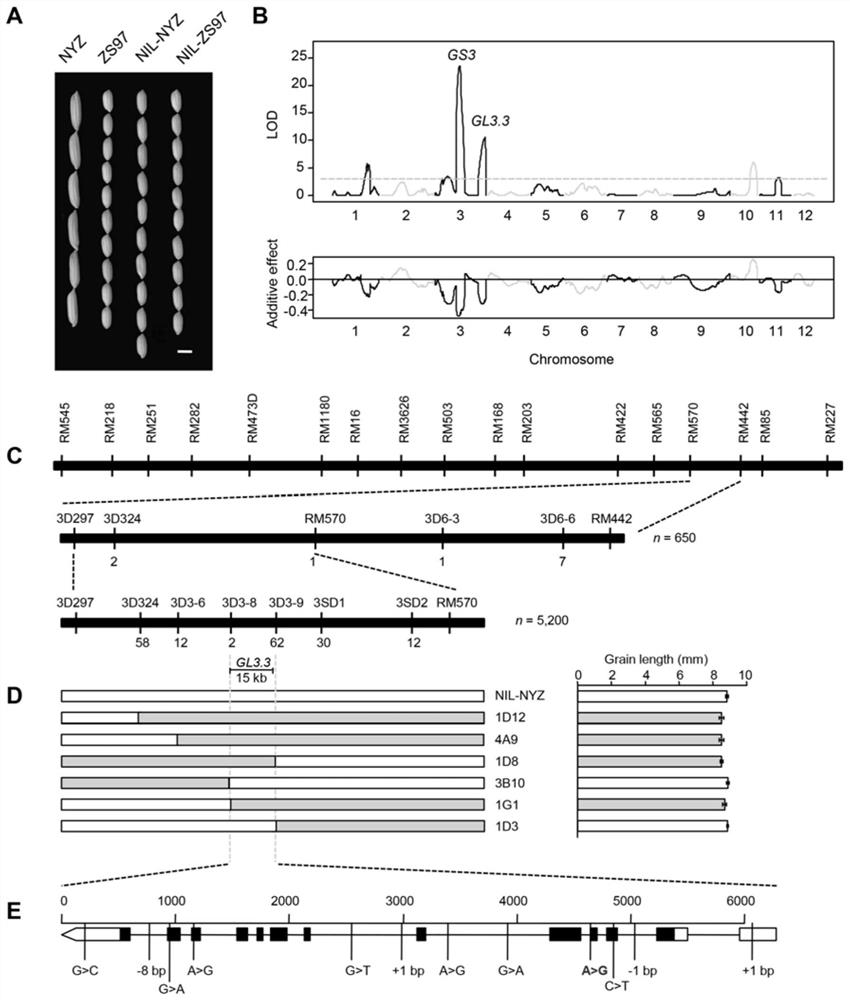Breeding method of super long-grain rice
A technology of super-long rice, applied in the direction of chemical instruments and methods, biochemical equipment and methods, microbial measurement/inspection, etc., to achieve the effects of saving production costs, shortening the breeding cycle, and improving selection efficiency
- Summary
- Abstract
- Description
- Claims
- Application Information
AI Technical Summary
Problems solved by technology
Method used
Image
Examples
Embodiment 1
[0060] Example 1: Location of grain length main gene GL3.3
[0061] 1. Construction of recombinant inbred line population
[0062] F 1 (parental seed morphology see figure 2 Figure A in ), and then self-crossed, a total of 190 strains of F 2 group. The F of these 190 individual plants 2 The population can follow the "one-grain pass" method (Fang Xuanjun et al., 2000), and continue to self-cross until F 7 generation( figure 1 ).
[0063] 2. Genotype identification and genetic map construction
[0064]The identification method of genotype is conventional SSR analysis method. For specific steps, the first choice is to screen polymorphic SSR primers. A total of 574 pairs of SSR primers were screened in the present invention, including 452 pairs of primers of RM series and 118 pairs of primers of MRG series. RM series primers had 185 pairs of polymorphic markers between rice varieties Nanyangzhan and Zhenshan 97, and MRG series primers had 54 pairs of polymorphic markers...
Embodiment 2
[0069] Example 2: Functional verification and effect analysis of GL3.3
[0070] 1. Function verification of GL3.3
[0071] Os03g0841800 encodes a 6281kb open reading frame (ORF) consisting of 12 exons and 11 introns, annotated as GSK5 in the japonica rice "Nipponbare" reference genome (Kawahara et al., 2013). In order to further confirm whether Os03g0841800 is GL3.3, the applicant knocked out the GSK5 gene in the short-grain indica rice Zhenshan 97 using the CRISPR / Cas9 system (Shan et al., 2013). The applicant has obtained two kinds of mutants ( image 3 Figure A in the to image 3 Figure E in). Both mutant plants had significantly increased grain length and grain weight compared to wild-type ZS97 (non-transgenic) (see image 3 Figures C to E in image 3 in the figure). On the other hand, the applicant complementarily transformed the allelic gene of GL3.3 in "ZS97" in "NYZ" (Hiei et al., 1994). The results of the analysis showed that the transgenic negative plants had ...
Embodiment 3
[0078] Example 3: Application of GL3.3 in improving rice grain length
[0079] GL3.3 located in the present invention is a rare and major grain length gene, and can interact with GS3 to exert a stronger function to form a super-long grain phenotype, which can effectively improve the grain length of existing cultivated rice varieties traits. In the breeding process, molecular markers of GL3.3 can be used for assisted selection, which can reduce the planting area, simplify the breeding process and save manpower and material resources, so as to improve the breeding efficiency. Therefore, the rice germplasm material (such as the variety "Nanyangzhan" in this experiment) has the non-functional allele of GL3.3 (gl3.3 Aus and gl3.3 Jap ) materials are used to improve rice grain length traits, and have a very broad application prospect.
[0080] The technical route of this embodiment can be found in Figure 7 the method described, Figure 7It is the overall technical process desi...
PUM
 Login to View More
Login to View More Abstract
Description
Claims
Application Information
 Login to View More
Login to View More - R&D
- Intellectual Property
- Life Sciences
- Materials
- Tech Scout
- Unparalleled Data Quality
- Higher Quality Content
- 60% Fewer Hallucinations
Browse by: Latest US Patents, China's latest patents, Technical Efficacy Thesaurus, Application Domain, Technology Topic, Popular Technical Reports.
© 2025 PatSnap. All rights reserved.Legal|Privacy policy|Modern Slavery Act Transparency Statement|Sitemap|About US| Contact US: help@patsnap.com



